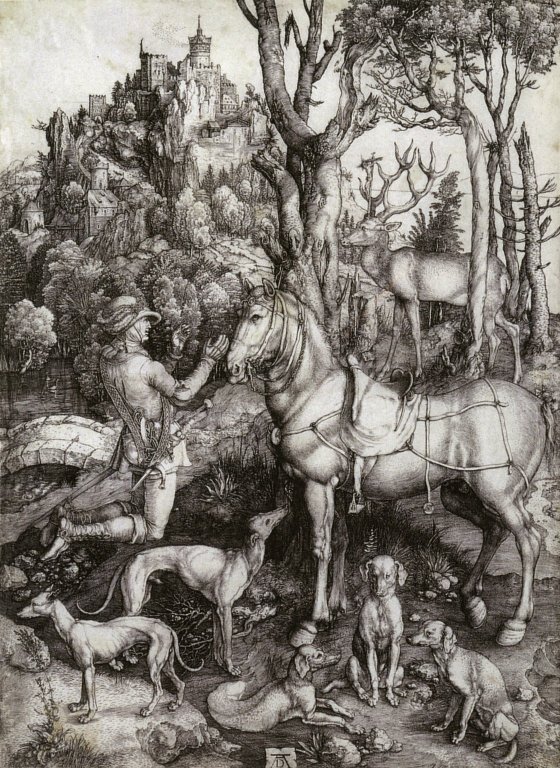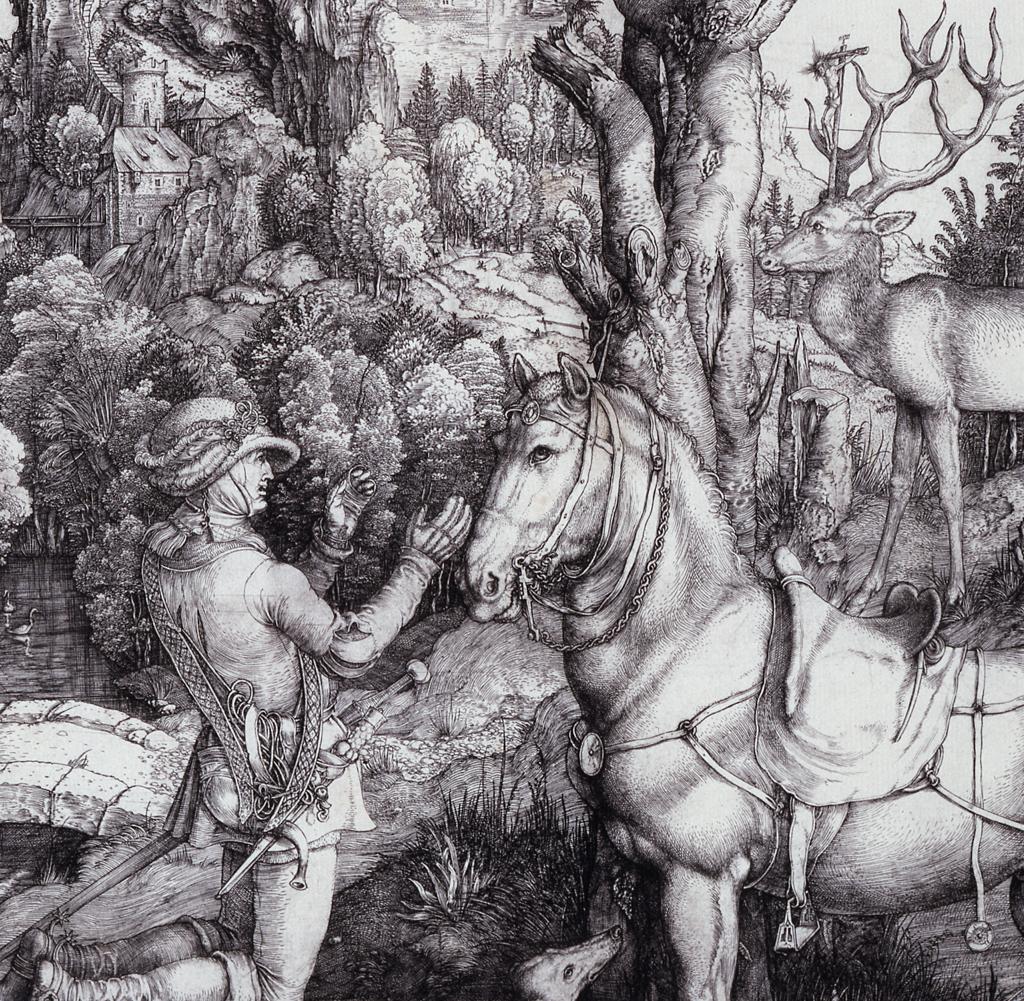St. Eustace

Albrecht Dürer, St. Eustace, ca. 1501. Engraving, 35.6 x 25.9 cm. St. Louis, Saint Louis Art Museum, inv. no. 255:1916.
This engraving portrays the conversion of Placidus, a Roman military commander, to Christianity. In the Golden Legend (the compilation of stories relating the lives of saints written by Jacobus de Varagine in the thirteenth century), Placidus encounters a stag while he is out hunting in the woods. Upon seeing the crucified Christ on the cross between the animal’s antlers, Placidus takes on the name Eustace and becomes the patron saint of hunters. St. Eustace was a popular devotional figure, and he was represented in many artworks in the fifteenth and sixteenth centuries. St. Eustace is one of Dürer’s most ambitious works, rivaling paintings in size. In Dürer’s rendering of the story, the figure is on the verge of conversion. He is experiencing a spiritual vision and praying to acknowledge his devotion to God simultaneously. Viewers are privileged to witness this transient moment and are invited to imitate St. Eustace’s act of worship.
St. Eustace offers the viewer a plethora of minutely defined details. Dürer achieves wonderful tonal values throughout the engraving due to the concentrated use of hatching and cross-hatching on the copperplate. In the immediate foreground, five dogs rest in a variety of positions. Illustrating animals in different poses was not an easy task, and Vasari, the Italian Renaissance painter and historian, greatly admired Dürer’s efforts in this engraving (note 1). The dogs are naturalistic: they have lustrous hair and convey individuality through their physique. As living symbols of faith, they are noble companions to St. Eustace. The protagonist has dismounted his horse, and he raises his hands and kneels before the majestic stag that carries a cross between its antlers. By showing the live animals in static positions, Dürer emphasizes the momentary element of this vision in the woods. At any moment the stag could run away, negating Eustace’s opportunity to see the cross, and accordingly, its stillness is fundamental to the man’s conversion. Sighting the cross is not an easy task, yet part of the engraving’s appeal is to locate this religious symbol. Those fortunate enough to own an impression of the print could experience viewing a divine event within the confines of their own home. This engraving acted as a devotional piece and illustrated that spiritual encounters could occur in everyday settings.
Beyond the shoulders of St. Eustace, Dürer depicts a small stone bridge and a waterway that guide the viewer towards the back of the composition. A mountainous terrain, with a fortress at the top, appears amidst an abundance of leafy trees. At the very top of the engraving, besides the fortress’ tower, Dürer even accounts for a flock of birds by forming tiny dots, an early example of the use of stippling. No element in St. Eustace is overlooked, and in the opinion of many collectors, it became one of the most sought-after engravings to possess. In the first half of the nineteenth century, an artist even hand-colored a surviving impression of St. Eustace, along with a few other prints produced by Dürer, attesting to the engraving’s long legacy (note 2).
Dürer’s Study of Rocks, Pond in the Woods, and A Dog Resting can function as independent artworks that display high levels of artistic virtue, or as observations for some of his more elaborate artworks, such as St. Eustace. The expansive compendium of aspects from the natural world in the St. Eustace engraving are presented to the viewer in a fashion that underlines Dürer’s belief that emulating nature creates the highest form of art. Beholders are captivated as much by the landscape and animals, if not more, than by St. Eustace’s experience (note 3). Thus, it is not surprising that Dürer elected to bring along several impressions of this print with him to the Netherlands in 1520 (twenty years after completing the engraving), with the purpose of selling a devotional work that exhibited a rich array of natural elements and his virtuosic skills.
Notes:
note 1. In Lives of the Painters, Sculptors and Architects, Vasari praises Dürer extensively in his chapter on the Italian printmaker Marcantonio Raimondi. See Girogio Vasari, Lives of the Painters, Sculptors and Architects, trans. G. du C. de Verre, vol. 2, (New York, 1996), 74-100.
note 2. For more information on this colored engraving and other hand-colored prints by Dürer, see Susan Dackerman ed., Painted Prints: The Revelation of Color in Northern Renaissance & Baroque Engravings, Etchings & Woodcuts, (Pennsylvania, 2002).
note 3. This sentiment was first raised by Erwin Panofsky in E. Panofsky, The Life and Art of Albrecht Dürer, (Princeton, 1955), 81.
